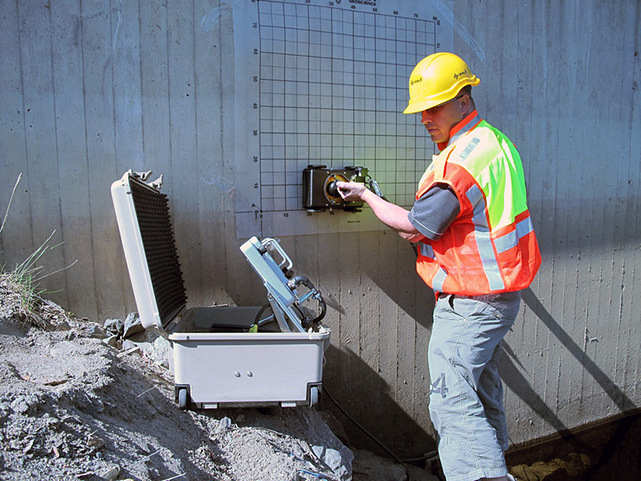Extensive Insights right into Concrete Scanning Procedures
Extensive Insights right into Concrete Scanning Procedures
Blog Article
Elevate Your Construction Refine With the Strategic Insights of Concrete Scanning for Improved Productivity
In the realm of modern building practices, the mission for efficiency and accuracy is vital. Embracing ingenious modern technologies has become a keystone for achieving these objectives. One such modern technology that has transformed the construction industry is concrete scanning. By taking advantage of the critical insights supplied by concrete scanning, building professionals can open a world of boosted performance and structured procedures. The implications of integrating concrete scanning go much past surface-level advantages, offering a profound effect on job outcomes.

Benefits of Concrete Scanning
Enhancing project effectiveness and security, concrete scanning provides a non-destructive method for spotting concealed items within concrete structures. By utilizing technologies such as ground-penetrating radar (GPR) and concrete x-ray imaging, building and construction groups can properly find rebar, post-tension cable televisions, electrical avenues, and other blockages prior to drilling, cutting, or coring right into concrete.
The advantages of concrete scanning are many. To start with, it decreases the danger of unexpected damage to important architectural elements, lowering the chance of costly fixings and job hold-ups. Second of all, it improves worker safety by giving real-time insights right into the location of surprise dangers. Building and construction sites can be intricate environments, and knowing what exists beneath the surface can protect against injuries and crashes.
In addition, concrete scanning promotes total task efficiency by simplifying process and stopping rework. By recognizing potential issues early, teams can adjust their strategies proactively, conserving time and sources over time. Fundamentally, the fostering of concrete scanning technologies is a calculated financial investment that pays dividends in terms of cost-effectiveness, efficiency, and security.
Technology Combination for Efficiency
Concrete scanning's ability to streamline process and boost project effectiveness can be further optimized via calculated assimilation of cutting-edge technologies. By including Structure Information Modeling (BIM) software program into concrete scanning processes, building teams can accomplish a higher degree of precision and sychronisation. Additionally, the assimilation of Increased Fact (AR) technology with concrete scanning can boost on-site visualization, permitting job managers and employees to overlay electronic information onto the physical environment in real time.
Preventing Pricey Errors
How can meticulous attention to information throughout concrete scanning procedures aid building groups in preventing costly mistakes? By utilizing sophisticated scanning technologies such as Ground Passing Through Radar (GPR) and electromagnetic induction, building and construction teams can properly find rebar, utilities, gaps, and other blockages within concrete frameworks. Additionally, concrete scanning assists in making certain architectural honesty by recognizing weak points or issues in the concrete very early on, enabling for prompt fixings and adjustments.
Enhancing Project Monitoring
Meticulous attention to information throughout concrete scanning processes not just assists in preventing expensive mistakes however also lays a strong structure for reliable job monitoring in building and construction endeavors. By including concrete scanning technology into project management strategies, building and construction teams can simplify operations, enhance interaction, and guarantee that projects remain on track.
Concrete scanning supplies valuable insights right into the architectural stability of existing elements, enabling task supervisors to make educated decisions concerning layout adjustments or building sequences. This proactive technique lessens the risk of unanticipated hold-ups or revamp, inevitably saving time and sources. In addition, the data obtained from concrete scanning can be integrated right into Building Information Modeling (BIM) systems, enabling real-time collaboration and sychronisation among various stakeholders.
Moreover, concrete scanning aids project supervisors identify possible risks or obstacles before they intensify right into bigger concerns, promoting a more secure workplace for all involved. With boosted exposure and precision given by concrete scanning modern technology, task managers can effectively plan, monitor, and implement building projects with higher efficiency and self-confidence.
Optimizing Productivity
One vital aspect of maximizing performance is through the adoption of concrete scanning innovation. By utilizing ground-penetrating radar (GPR) and other scanning methods, construction visit our website teams can accurately find rebar, channels, and various other subsurface elements, minimizing the risk of costly mistakes and delays during excavation and boring.
In addition, welcoming Structure Info Modeling (BIM) software program can considerably enhance efficiency by producing comprehensive 3D designs that improve project visualization and coordination among various professions. BIM permits much better clash detection, enabling concerns to be recognized and settled before construction also begins, saving time and resources over time.
Carrying out a lean construction approach, which concentrates on getting rid of waste and optimizing efficiency throughout all task stages, is another reliable approach for making best use of performance. By promoting collaboration, communication, and continual enhancement, construction groups can work extra cohesively in the direction of achieving task goals in a productive and structured manner.
Final Thought
In conclusion, the calculated implementation of concrete scanning in the building and construction procedure offers many advantages, including enhanced performance, expense financial savings, improved project monitoring, and enhanced efficiency. By incorporating this technology, construction teams can prevent costly errors, enhance their operations, and optimize their overall project outcome. Concrete scanning is a valuable tool that can raise the building and construction process and check my reference bring about more lucrative and successful outcomes.

Report this page